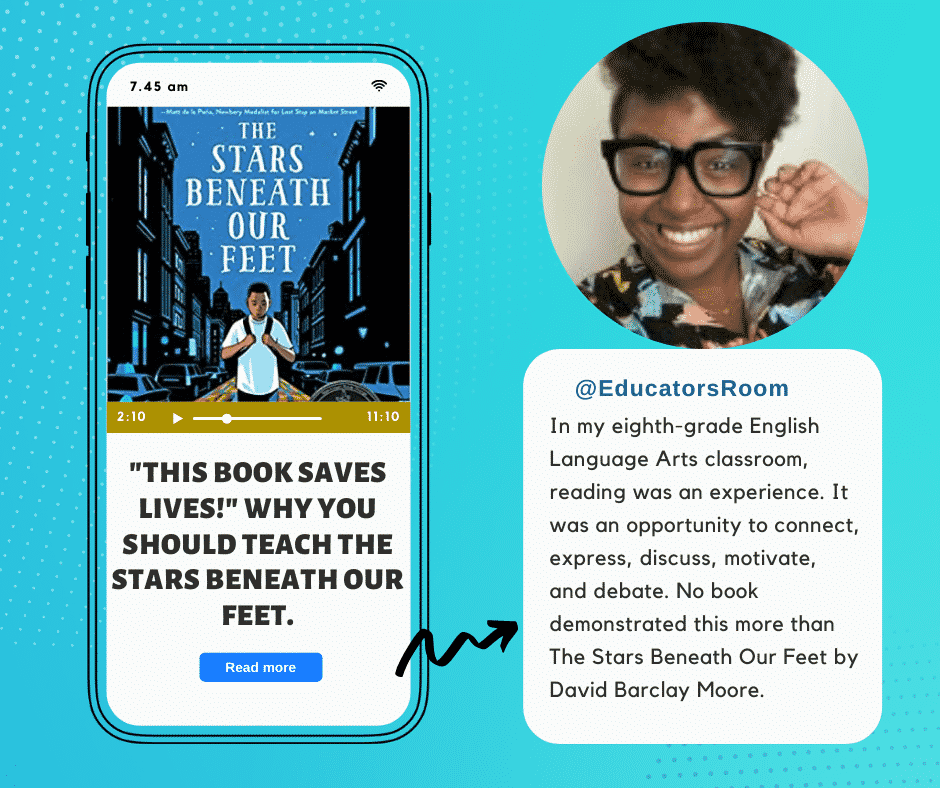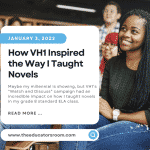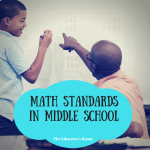In my eighth-grade English Language Arts classroom, reading was an experience. It was an opportunity to connect, express, discuss, motivate, and debate. No book demonstrated this more than The Stars Beneath Our Feet by David Barclay Moore. There will be NO spoilers in this piece (well nothing that you can’t find out by reading the back of the book); this is just a discussion of the profound impact The Stars Beneath Our Feet had on my students and me.
The Impact of Reading The Stars Beneath Our Feet
Many of my students connected to The Stars Beneath Our Feet on an immediate, human level. We, teachers, have this awful habit of saying, “When you get out into the real world,” neglecting that our students already live in and experience the unfairness of the “real world” every day.
A student who grappled with his own struggles found hope in Lolly’s story. A student who experienced so much loss found strength in Lolly’s story. For many of my students, reading Lolly’s experiences became opportunities to discuss their own. His friends, his parents, his mentors, and teachers reminded them of their own. Nearly everyone who participated in our reading experience– the students, my teacher’s aide, the observing administrator, and department chair, me– gained something. In a recommendation, one student proclaimed “This book saves lives!” a sentiment that I feel captures the power of The Stars Beneath Our Feet.
The Themes in The Stars Beneath Our Feet
It’s important to note that while the overwhelming majority of my students enjoyed reading The Stars Beneath Our Feet, there were students who did not. One student angrily wrote in a feedback survey, “This book is depressing! It’s a book about a kid whose brother was shot and died. Why would I want to read that?” While I believe that The Stars Beneath Our Feet is an incredible novel, it can be intense and this should be taken into consideration when teaching this novel with students. You never know what emotions will be stirred when discussing and exploring the themes in this novel.
While reading The Stars Beneath Our Feet, my students and I discussed many of the following topics: divorce and separation, bullying, peer pressure, friendship, homophobia, drugs, suicide, gun violence, gangs, grief and loss, mental health and coping, and more. Lolly’s story and narration are so relatable, so real that the novel served as a jumping-off point for us to ponder real-world issues. The topics reflected the issues that my students were dealing with or had questions about themselves.
My Favorite Activity We Did While Reading
My favorite activity that I designed for the novel was called, “As Lolly’s Friend.” I began the lesson by having students give me a list of challenges that teenagers face. I recorded them on the board as they shouted them out (virtually, I used Jamboard to record the list). Then I asked them which challenges on the board reflected the ones that Lolly faces in The Stars Beneath Our Feet.
After the lesson introduction, I explained to students that in this lesson scenario they are close friends of Lolly’s. They see how he is struggling and want to help. They were going to choose one of the challenges that Lolly faces and recommend a resource that may help him overcome his challenge. Prior to the lesson, I had compiled a list of resources for different issues that Lolly faces in the novel. These resources included podcasts, videos, interviews, articles, and digital resources such as Nemours Kids Health. After the students reviewed the resources and decided which ones would be best for Lolly, we had a Socratic Seminar discussing why the students selected the resources and whether they would be useful. Not only did the students find resources for Lolly, but they also found resources for themselves.
Reflecting on Teaching The Stars Beneath Our Feet
I loved teaching The Stars Beneath Our Feet. To me, reading has always created opportunities to explore new worlds and characters different from ourselves. But The Stars Beneath Our Feet created an opportunity for us to explore ourselves while following Lolly’s journey. At the end of the novel, Lolly finds his way, and he gives us hope that we will find ours too.






